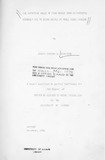| dc.description.abstract | Four arable farm by-products were evaluated in a trial
conducted at the National Agricultural Research Station, Kitale
in 1977. The trial lasted 8 months. Green maize stalks, maize
cobs, sugarcane rejects and sugarcane tops were the by-products
evaluated. The main objective of the trial was to evaluate the
nutritive value of the by-products using both in vivo and in vitro digestibility techniques.
The by-products were composed of high crude fibre and ash,low ether extracts and crude protein. The gross energy of maize stalks (4.3 kcal/g), maize cobs (4.4 kcal/g), sugarcane (3.9 kcal/g) and sugarcane tops (3.8 kcal/g) were not different (P> .05) and their respective digestible energy was 2.8, 2.4, 2.3 and 2.0 kcaljg.' Neutral detergent fibre(NDF) of sugarcane was lower:(P<.05)than that of maizet stalks , maize cobs and sugarcane tops.The by-products were highly lignified, with ADL values ranging
from 4.4 to, 5.8 % DM.
Sheep fed maize stalks and sugarcane tops were in positive nitrogen (N) balance and negative N-balance in those fed sugarcane and maize cobs. This observation emphasized the need for supplementary protein in the by-product based diets.
All by-products were rich in calcium and potassium (except maize cobs) and poor in sodium and phosphorus. Wether sheep fed these by-products were in positive calcium and potassium balances and negative phosphorus balance. There was positive sodium (Na) balance in those• sheep fed sugarcane tops while negative Na balance in those fed maize stalks, sugarcane and maize cobs.
It was recommended that animals should be supplemented with minerals when fed these by-products.Mean daily dry matter (DM) intakes of maize stalks (1007.5 g). maize cobs (553.1 g)t sugarcane (299.5 g) and sugarcane tops (864.3 g) were different (P <.05). The feeds were readily accepted by sheep. The DM intakes by sheep fed maize stalks,maize cobs,sugarcane and sugarcane tops were 2.6. 1.3. 1.0 and 2.0 % body weight, respectively.
Mean daily organic matter intakes of maize stalks (926.9 g), maize cobs (531.4 g). sugarcane (293.3 g) and sugarcane tops (794.8 g) were different (P <.05).
Average daily digestible organic matter intakes of maize stalks, maize cobs, sugarcane and sugarcane tops were 585.0,329.3, 183.9 and 447.5 g, respectively and were different
(P <.05). Liveweight changes of sheep fed these by-products were + 350, -110, - 510 and -10 g\day respectively.
Apparent dry matter digestibility (OMO) of maize stalks (63.8 %), maize cobs (60.1%) and sugarcane (60.8%) were not different (P> .05) but were higher (P< .05) than sugarcane tops (54.3%). Organic matter digestibility (OMO) of maize stalks (63.8%), maize cobs (60.6%) and sugarcane (62.9%) were not different (P> .05) but were higher (P <.05) than sugarcane tops (56.2%). All by-products had positive crude protein digestibility except sugarcane (- 25.1%).
TDN of maize stalks (60.2%). maize cobs (61.6%) and sugarcane (62.3%) were not different (P >.05) but were higher (P< .05) than sugarcane tops (51.4%). SE values of maize stalks, maize cobs. sugarcane and sugarcane tops were .45,42,50 and .32
SE/kg or~ and were different (P <.05).
Daily gross energy (GE) intakes of maize stalks (4402.9 kcal)
and sugarcane tops (3345.4 kcal) were higher (P< ,05) than maize
cobs (2178.3 kcal) and sugarcane (1160.7 kcal). Digestible
energy (DE) and Ne tabo lisable energy (ME) intakes of by-products
were different (P< .05). GE, DE and ME intakes per kg DM of the
by-products were within close range of energy values. Much of
the energy was lost through faeces, fermentation gases and urine.
DMD was estimated by Van Soest technique. Results showed
OMD of maize stalks, maize cobs and sugarcane tops largely
depended on the NDF wh ile DMD of sugarcane depended on NOS. In
vivo DMD and OMD ~ould not be predicted from NDF, NDS, ADF or ADL.
Two stage in vi-tro m~D of maize stalks, maize cobs, sugarcane
and sugarcane tops was 66.5, 58.8, 65.9 and 54.8 %; OMDOM was
64.8, 58.3, 65.1 and 52.9 % and OMDDM (D-values) was 60.1, 57.3,
63.3 and 47.7 percent, respectively. OMDOM and OMDDM were lower
than DMD due to ash contents of the by-products. It was recommended
that sugarcane be derinded before being fed for optimum utilization
by animals. In vivo DMD and OMO were accurately predicted from
in vitro DMD, OMD and OMDDM. Initial screening of these byproducts
may be carri ed out by in vitro techn iques. The most
promising by-products may be recommended for_final evaluation,
using animal feeding trials.
Rate of in vitro dry and organic matter disappearance
established important factors which need careful consideration
when high fibre by-products are fed to livestock. There were
highly significant (P< .05) and linear relationships between
DMD, OMD, OMDDM and time. These suggested that digestion of
the by-products is heavily dependant on time of incubation in
the rumen liquor. It was recommended that these by-products
need to be physically or chemically treated to make them more
acceptable and digestible before being fed to livestock.
It was proposed that in future. research should be directed
towards the effects of nitrogen and mineral supplementation •.
A study to investigate performance of dairy animals fed rations.
based on these by-products, especially under zero grazing
system, should be encouraged. | en |

